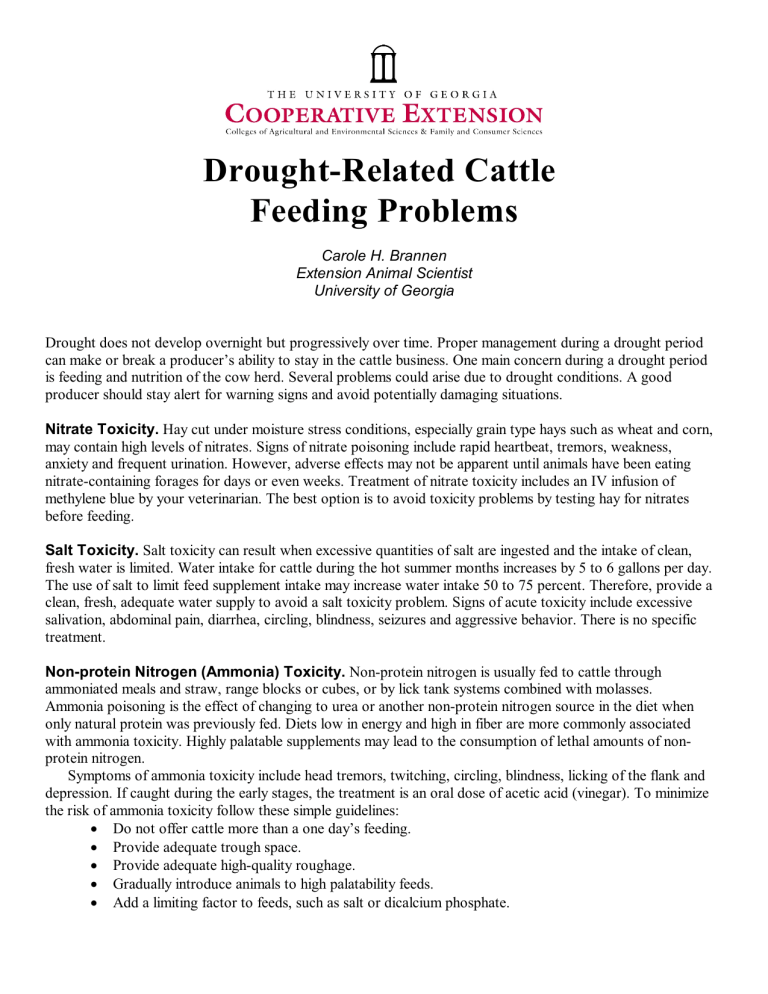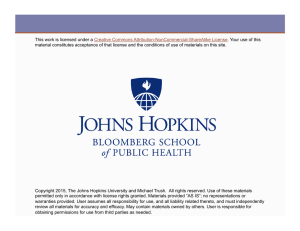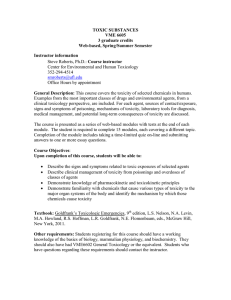Drought-Related Cattle Feeding Problems

Drought-Related Cattle
Feeding Problems
Carole H. Brannen
Extension Animal Scientist
University of Georgia
Drought does not develop overnight but progressively over time. Proper management during a drought period can make or break a producer’s ability to stay in the cattle business. One main concern during a drought period is feeding and nutrition of the cow herd. Several problems could arise due to drought conditions. A good producer should stay alert for warning signs and avoid potentially damaging situations.
Nitrate Toxicity.
Hay cut under moisture stress conditions, especially grain type hays such as wheat and corn, may contain high levels of nitrates. Signs of nitrate poisoning include rapid heartbeat, tremors, weakness, anxiety and frequent urination. However, adverse effects may not be apparent until animals have been eating nitrate-containing forages for days or even weeks. Treatment of nitrate toxicity includes an IV infusion of methylene blue by your veterinarian. The best option is to avoid toxicity problems by testing hay for nitrates before feeding.
Salt Toxicity.
Salt toxicity can result when excessive quantities of salt are ingested and the intake of clean, fresh water is limited. Water intake for cattle during the hot summer months increases by 5 to 6 gallons per day.
The use of salt to limit feed supplement intake may increase water intake 50 to 75 percent. Therefore, provide a clean, fresh, adequate water supply to avoid a salt toxicity problem. Signs of acute toxicity include excessive salivation, abdominal pain, diarrhea, circling, blindness, seizures and aggressive behavior. There is no specific treatment.
Non-protein Nitrogen (Ammonia) Toxicity.
Non-protein nitrogen is usually fed to cattle through ammoniated meals and straw, range blocks or cubes, or by lick tank systems combined with molasses.
Ammonia poisoning is the effect of changing to urea or another non-protein nitrogen source in the diet when only natural protein was previously fed. Diets low in energy and high in fiber are more commonly associated with ammonia toxicity. Highly palatable supplements may lead to the consumption of lethal amounts of nonprotein nitrogen.
Symptoms of ammonia toxicity include head tremors, twitching, circling, blindness, licking of the flank and depression. If caught during the early stages, the treatment is an oral dose of acetic acid (vinegar). To minimize the risk of ammonia toxicity follow these simple guidelines:
· Do not offer cattle more than a one day’s feeding.
· Provide adequate trough space.
· Provide adequate high-quality roughage.
· Gradually introduce animals to high palatability feeds.
· Add a limiting factor to feeds, such as salt or dicalcium phosphate.
Prussic Acid (Cyanide) Poisoning.
Prussic acid or cyanide poisoning can also be a problem when grazing drought-stunted plants such as sorghum, sorghum hybrids and sudan grass. Symptoms include rapid respiration, salivation, spasms and staggering. If diagnosed early enough, treatment is an option. Be careful; prussic acid poisoning symptoms are very similar to nitrate toxicity, but the treatments are very different. If possible, do not allow grazing on pasture grasses (sudan grass and sorghum-sudan hybrids) until they are 15-18 inches tall to reduce risk of poisoning. Sorghums should be several feet tall. If the forage is being cut for hay, allow it to suncure thoroughly for three to five days, bleaching out any green color to reduce prussic acid problems.
Poisonous Plants .
Cattle grazing short pastures are more likely to consume potentially poisonous plants.
Many poisonous plants are unpalatable but may be consumed when the quantity of grass is in short supply.
Poisonous plants can cause a range of symptoms when ingested including death, chronic illness, debilitation, weight loss, abortions, birth defects and others. Producers should get to know the poisonous plants common to their area and watch for changes in their cattle. Refer to Poisonous Plants of the Southeastern United States at http://www.aces.edu/pubs/docs/A/ANR-0975/ANR-0975.pdf
for plant identification and specific toxicity diagnosis.
Rumen Impaction.
Rumen impaction may occur when cattle receive inadequate protein (less than 7 to 8 percent CP in the total diet) and too much low-quality high-fiber forage such as drought affected pasture or forage substitutes such as peanut hulls, straws or gin trash. A lack of adequate water can also contribute to compaction. Complete anorexia, scant feces, moderate distention of the abdomen, weight loss and weakness are usually the initial signs. The heart rate may be increased, and mild dehydration is common. Treatment is an option, but it is best to test the quality of forages fed, provide an adequate supplement when needed, and offer a good water source to avoid potential problems.
Hardware Disease.
Hay harvested from vacant lots, roadsides and fields not commonly used for hay may contain nails, wire or foreign objects. These items can pierce the rumen wall and cause hardware disease. Signs of hardware disease are shallow and rapid respiration. Initially, the cow exhibits an arched back; an anxious expression; a reluctance to move; and an uneasy, careful gait. Forced sudden movements as well as defecating, urinating, lying down, getting up and stepping over barriers may be accompanied by groaning. Treatment is available. Close observation of feeds and hays and the use of magnets in feed mixing equipment can help reduce the risk of cattle eating problem materials.
Drought conditions not only cause undue stress on the producer, but they also add a list of other problems that need to be watched for. By using good management techniques and caution, these problems can be avoided.
The University of Georgia and Ft. Valley State University, the U.S. Departm ent of Agriculture and counties of the state cooperating.
Cooperative Extension, the University of Georgia College of Agricultural and Environm ental Sciences, offers educational program s, assistance and materials to all people without regard to race, color, national origin, age, gender or disability.
An Equal Opportunity Em ployer/Affirm ative Action Organization Com m itted to a Diverse W ork Force
SB-51
Issued in furtherance of Cooperative Extension work, Acts of May 8 and June 30, 1914, The University of Georgia College of
Agricultural and Environm ental Sciences and the U.S. Departm ent of Agriculture cooperating.
J. Scott Angle, Dean and Director
August 2007





